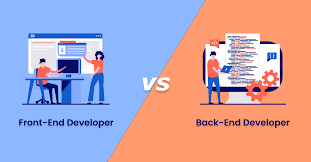
Frontend Vs Backend Development
In the world of web development, two primary roles are crucial for building functional, visually appealing, and user-friendly websites: frontend and backend development. While both are essential for creating a fully operational website, they focus on different aspects and require distinct skill sets. This article explores the differences between frontend and backend development, their respective roles, and how they work together to deliver a seamless user experience.
What is Frontend Development? Frontend development, also known as client-side development, involves everything that users see and interact with on a website. It focuses on the visual aspects, layout, and user experience (UX) of a site. Frontend developers use a combination of HTML, CSS, and JavaScript to build the user interface (UI) and ensure it is responsive, intuitive, and visually appealing.
Key Responsibilities of Frontend Developers:
Design Implementation: Frontend developers take design mockups created by UI/UX designers and turn them into functional web pages. They ensure that the website looks as intended across different browsers and devices.
User Interaction: They create interactive elements such as buttons, forms, sliders, and navigation menus. JavaScript and frameworks like React, Angular, or Vue.js are often used to add interactivity and dynamic content.
Responsive Design: Ensuring that websites are responsive and accessible on various screen sizes and devices is a critical aspect of frontend development. This involves using CSS frameworks like Bootstrap or writing custom media queries.
Performance Optimization: Frontend developers work to optimize the performance of websites by minimizing load times and improving overall efficiency. Techniques include image optimization, code minification, and leveraging browser caching.
What is Backend Development? Backend development, or server-side development, involves the behind-the-scenes functionality of a website. It focuses on the server, databases, and application logic that power the website. Backend developers use programming languages like Python, Ruby, PHP, Java, and frameworks like Node.js, Django, or Laravel to build and maintain the server-side components.
Key Responsibilities of Backend Developers:
Server Management: Backend developers set up and maintain the server infrastructure that hosts the website. This includes configuring servers, managing server security, and ensuring uptime and performance.
Database Management: They design and manage databases that store and retrieve data for the website. This involves creating database schemas, writing queries, and ensuring data integrity and security. Common databases include MySQL, PostgreSQL, MongoDB, and SQLite.
Application Logic: Backend developers write the code that handles the logic and functionality of the website. This includes user authentication, data validation, business logic, and API (Application Programming Interface) development.
Integration: They integrate third-party services and APIs into the website, such as payment gateways, social media logins, and other external services that enhance functionality.
How Frontend and Backend Work Together Frontend and backend development are inherently interconnected, and both teams must collaborate closely to create a seamless, functional website. Here’s how they work together:
Data Flow: The backend handles data storage, retrieval, and processing. When a user interacts with the frontend (e.g., submitting a form), the data is sent to the backend, where it is processed and stored in the database. The backend then sends the processed data back to the frontend for display.
APIs: Backend developers create APIs that allow the frontend to communicate with the server. APIs define the endpoints through which data can be requested or sent, ensuring a smooth exchange of information between the client and server.
User Authentication: User authentication involves both frontend and backend components. The frontend collects user credentials (e.g., username and password) and sends them to the backend, which verifies the credentials, manages sessions, and returns the authentication status.
Error Handling: Both frontend and backend developers must handle errors gracefully. The backend handles server-side errors and sends appropriate responses to the frontend, which then displays user-friendly error messages or prompts.
Choosing Between Frontend and Backend Development Choosing between frontend and backend development depends on your interests, skills, and career goals. If you have a passion for design, creativity, and user experience, frontend development may be more suitable for you. If you enjoy problem-solving, logic, and working with servers and databases, backend development might be a better fit.
Many developers also choose to become full-stack developers, gaining proficiency in both frontend and backend technologies. This allows them to build complete web applications from start to finish and understand the entire development process.
Frontend and backend development are two distinct but complementary aspects of web development. While frontend developers focus on the visual and interactive elements that users interact with, backend developers handle the underlying functionality, data management, and server-side logic. Both roles are essential for creating robust, efficient, and user-friendly websites. By understanding the differences and how they work together, aspiring developers can choose a path that aligns with their interests and career aspirations.




